Shedd Aquarium
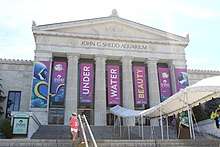 Entrance in July 2018 | |
| Date opened | May 30, 1930 |
|---|---|
| Location | 1200 South Lake Shore Drive Chicago, Illinois, United States |
| No. of animals | 32,000[1] |
| No. of species | 1,500 |
| Total volume of tanks | 5 million US gallons (19,000 m3) |
| Annual visitors | 2.02 Million[2] |
| Memberships | AZA,[3] AMMPA,[4] WAZA[5] |
| Major exhibits | Amazon Rising, Caribbean Reef, Abbott Oceanarium, Polar Play Zone, Waters of the World, Wild Reef[6] |
| Website |
www |
|
Shedd Aquarium | |
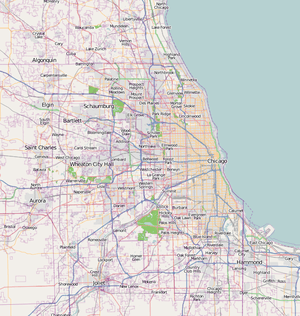   | |
| Location | Chicago, Illinois |
|---|---|
| Coordinates | 41°52′4″N 87°36′50″W / 41.86778°N 87.61389°WCoordinates: 41°52′4″N 87°36′50″W / 41.86778°N 87.61389°W |
| Built | 1929 |
| Architect | Graham, Anderson, Probst & White |
| NRHP reference # | [7] |
| Significant dates | |
| Added to NRHP | February 27, 1987 |
| Designated NHL | February 27, 1987[8] |
Shedd Aquarium (formally the John G. Shedd Aquarium) is an indoor public aquarium in Chicago, Illinois in the United States that opened on May 30, 1930. The aquarium contains 32,000 animals,[1] and was for some time the largest indoor aquarium in the world with 5,000,000 US gallons (19,000,000 l; 4,200,000 imp gal) of water. Shedd Aquarium was the first inland aquarium with a permanent saltwater fish collection. Located on Lake Michigan, it is located on the Museum Campus Chicago, which it shares with the Adler Planetarium and the Field Museum of Natural History. In 2015, the aquarium had 2.02 million visitors. It was the most visited aquarium in the U.S. in 2005, and in 2007, it surpassed the Field Museum as the most popular cultural attraction in Chicago.[9] The aquarium contains 1,500 species, including fish, marine mammals, birds, snakes, amphibians, and insects.[10] The aquarium received awards for "best exhibit" from the Association of Zoos and Aquariums (AZA) for Seahorse Symphony in 1999, Amazon Rising in 2001, and Wild Reef in 2004. It was designated a National Historic Landmark in 1987.
History

Shedd Aquarium was the gift of retail leader John G. Shedd, a protégé of Marshall Field (benefactor of the adjacent Field Museum), to the city of Chicago. Although Shedd only lived long enough to see the architect's first drawings for the aquarium, his widow, Mary R. Shedd, cut the ribbon at the official opening ceremony.
The aquarium cost $3,000,000 to build, and initially included 132 exhibit tanks .[11] Groundbreaking took place on November 2, 1927, and construction was completed on December 19, 1929; the first exhibits opened on May 30, 1930. As one of the first inland aquariums in the world, the Shedd had to rely on a custom-made railroad car, the Nautilus, for the transport of fish and seawater. The Nautilus lasted until 1959.
In 1930, 20 railroad tank cars made eight round trips between Key West and Chicago to transport 1,000,000 US gallons (3,800,000 l) of seawater for the Shedd's saltwater exhibits. In 1933, Chicago hosted its second world's fair, the Century of Progress. The Aquarium was located immediately north of the fairgrounds, and the museum gained exposure to a large international crowd.
In 1971, Shedd Aquarium added one of its most popular exhibits, a 90,000-US-gallon (340,000 l) exhibit reproducing a Caribbean coral reef. That same year, the aquarium acquired its first research vessel, a 75-foot (23 m) boat for exploring the Caribbean, manned by a crew to conduct field research and collect specimens. In 1985, this boat was replaced with the aquarium's current vessel, the Coral Reef II.
In 1987, Shedd Aquarium was placed on the National Register of Historic Places.
John Shedd's grandson, John Shedd Reed, who had served as president of Atchison, Topeka and Santa Fe Railroad from 1967 to 1986, was president of the aquarium's board from 1984 until 1994, and was a life trustee until his death in 2008.[12][13] Ted A. Beattie served as president and CEO of the aquarium from 1994 until his retirement in 2016. Bridget C. Coughlin assumed duties as President and CEO of the company in the Spring of 2016.[14]
Exhibits and presentations

There are several permanent exhibits at Shedd: Waters of the World, Caribbean Reef, Amazon Rising, Wild Reef, and the Abbott Oceanarium.
Waters of the World
The oldest galleries in the aquarium feature exhibits on oceans, rivers, islands and lakes, and Chicago's own local waters. Species on exhibit include Haraldmeier's mantella, a giant Pacific octopus, Gymnarchus, blue iguana, starfish, seahorses, and alligator snapping turtle.
Caribbean Reef
The Caribbean Reef exhibit was built in 1971, on the site of the aquarium's very first exhibit, the Tropical Pool. A feature of this exhibit is a diver that interacts with the animals while talking with the people. A part of the exhibit is a 90,000-US-gallon (340,000 l) circular tank that allows for maximum walk-around viewing. It was one of the first habitats to display schooling fish. It is also home to the rescued green sea turtle, Nickel, as well as bonnethead sharks, Tarpons, stingrays, and many more. The exhibit is near the center of the first floor. It is adjacent to Amazon Rising, Waters of the World, and Wild Reef.
Amazon Rising
The Amazon Rising exhibit is a 8,600-square-foot (800 m2) walkthrough flooded forest recreation of the Amazon River and the surrounding jungle. This exhibit contains 250 different species, and its highest water level is 6 feet (1.8 m). Species from this area on exhibit include anacondas, piranhas, spiders, freshwater stingrays and caimans.
Wild Reef
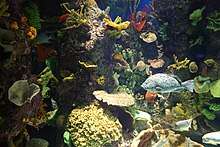
In 2003 Shedd opened Wild Reef, a permanent exhibit located two levels below the main building. The exhibit contains a total of 525,000 US gallons (1,990,000 l) and recreates a Philippine coral reef on the Apo Island marine reserve, complete with living coral, multiple species of fish and rays, and a collection of sharks such as sandbar, sawfish, zebra, and blacktip reef sharks. The main draw of this attraction is a 400,000-US-gallon (1,500,000 l) shark tank with 12-foot (3.7 m) high curved windows, allowing visitors a diver's-eye view. The Wild Reef exhibit also features a saltwater tank display area where coral is propagated and grown for conservation purposes.[15]
Stingray Touch
Opened on May 17, 2013, this exhibit allows guests to touch cownose rays and yellow spotted rays as they swim around their 20,000 US gallons (76,000 l) outdoor exhibit. Located on the aquarium's South Terrace, this exhibit is open seasonally from May through October (weather permitting).
Oceanarium
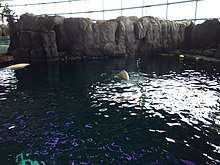
In 1991, Shedd Aquarium opened the Oceanarium (known since 2010 as the Abbott Oceanarium), a large addition to the aquarium that features marine mammals, including Pacific white-sided dolphins, belugas, sea otters and California sea lions, as well as penguins, that are located in the Polar Play Zone. The Polar Play Zone is an interactive play area for children as well as the home to the Magellanic and Rockhopper penguins. The lower level of the Oceanarium allows underwater viewing of the beluga whales and the dolphins. It holds 3,000,000 US gallons (11,000,000 l) in total; the largest single tank is the 2,000,000-US-gallon (7,600,000 l) "Whale Harbour".[16] The Oceanarium is the largest indoor marine mammal facility in the world.[17] Several of the sea otters that lived in the aquarium in the past were rescued from the Exxon Valdez oil spill in 1989.[16] In the fall of 2008, Shedd's Oceanarium was closed for preventive sealing as well as administrative upgrades. The animals in the exhibit area were temporarily moved to other zoos and aquariums until the exhibit reopened in May 2009.
Fantasea
Fantasea was a multiple animal show at Shedd Aquarium, running from October 16, 2009, through 2010. The show featured sea lions, beluga whales, penguins, hawks, and dolphins.
One World
One World aquatic presentation replaced Fantasea in 2013. The show can feature belugas, dolphins, penguins, sea lions, a hawk, and dogs. A holiday version is sometimes shown in November and December.
4D Theater
The 4D Theater opened in 2009 as part of the renovation of the Abbott Oceanarium. The 4D experience includes a 3D film with interactive seats, high-tech audio and interactive elements like scents and bubbles. Films shown have included Coastal Predators, Sea Monsters, SpongeBob SquarePants, Planet Earth, Ice Age, Dora the Explorer, Rudolph The Red Nosed Reindeer (seasonal), and the Polar Express (seasonal).
Previous special exhibits
Jellies
This exhibit opened in 2011, focusing on jellyfish, and the misconceptions surrounding them. It featured at least 10 species of jellyfish, including Moon jellyfish, Ctenophora (Comb jellyfish), Black sea nettle, Atlantic sea nettle, Jelly blubber and Flower hat jelly. The exhibit closed in 2015.[18]
Amphibians
The amphibian exhibit opened on May 15, 2015, and ran through January 1, 2018. It featured 40 different species of amphibians, including the gray tree frog, poison dart frog, fire-bellied toad, emperor newt, axolotl, tiger salamander, spring peeper, Japanese giant salamander, cane toad, and the marbled salamander.[19][20]
Current special exhibits
Underwater Beauty
This exhibit opened on May 25th, 2018, and focuses on the visual beauty of sea life, with sections called "Color", "Patterns", and "Rhythms." The exhibit features 100 different species of fish and invertebrate, displayed to accent their visual qualities, including the Spotted trunkfish, Ribbon eel, Powder blue tang, Purple tang, Scribbled angelfish, Lagoon jelly, Flower hat jelly, Blue-spotted spinefoot, Squarespot fairy basslet, Lined seahorse, Moorish idol, Maxima clam, Discus and Pyramid butterflyfish.[21]
Animals on exhibit, past and present
Australian Lungfish
Walter Chute, the aquarium's director from 1928 to 1964, wanted rare fish to attract the 10 million tourists expected to visit Chicago for the exposition in 1933. Granddad, an Australian lungfish, arrived at the Shedd in 1933, along with his mate, from Sydney during the Century of Progress world exposition. During the expo's run, they attracted about 4.5 million visitors.[22]
At Granddad's death in 2017, he was claimed by the aquarium to be the oldest fish in any aquarium in the world.[22] He was at least 86 and possibly older; he weighed 25 pounds (11 kg) and is 4 feet (1.2 m) in length. His normal behavior was to lay like a sunken log on the bottom of his habitat.
Beluga whales
Mauyak (F), Naya (F), Beethoven (M), Kayavak (F), Bella (F), Aurek (M), Grayson (M), and Kimalu (F).
In 2000, Mauyak gave birth to Qannik, who was sent to Point Defiance Zoo in Tacoma where he died in 2009. In 2006, the beluga whale Puiji gave birth to a female calf, later named Bella. On August 16, 2007 Mauyak gave birth yet again to a male calf named Miki, the Inuit word for ″small″ bringing the total number of successful beluga calf births at the aquarium to four since 1999. Miki has been moved to the Mystic Aquarium in 2016.
Kayavak, a young beluga whale, is one of the most famous residents of the Oceanarium. The whale became an orphan at only five months old after her mother, Immiayuk, died. Trainers fed Kayavak fish, cared for her day and night, taught her how to "be a whale," and she thrived to be the healthy adult she is today.
Puiji, another of Shedd Aquarium's beluga whales, gave birth to a 162-pound, five-foot, four-inch male calf on December 14, 2009.[23] Although it was a difficult birth, the calf survived and debuted to the public on Sunday, January 24, 2010.[24][25] He has since been named "Nunavik" meaning "friendly, beautiful, and wild". Nunavik currently lives at the Georgia Aquarium as of 2016.
Naluark was transferred to Mystic Aquarium & Institute for Exploration in Mystic, Connecticut in October 2011. He has since been moved to SeaWorld Orlando in 2016.
Another female beluga, named Naya, gave birth on December 20 to a 162-pound, five-foot two-inch male calf, though the calf died two days later from complications during birth.[26] Puiji died on Wednesday, October 26, 2011 following a seizure after having been undergoing treatment for an undisclosed medical condition over the course of several months.[27]
On August 27, 2012, Mauyak gave birth to a female calf, Kimalu, bringing the total number of belugas at Shedd to seven.[28]
Alaskan sea otters
Yaku (M), Mari (F), and Kiana (F)
Kenai (Exxon Valdez oil spill survivor) was euthanized on October 9, 2012 due to failing health brought on by advancing years.[29]
Kachemak (oldest sea otter in a North American Aquarium/Zoo) was euthanized on August 24, 2013 due to failing health related to age.[30]
Southern sea otters
Pacific white-sided dolphins
Kri (F), Ipo (F), Katrl (F), Munchkin (F), Sagu (M), Makoa (M), Kukdlaa (M)
Sagu and Makoa were conceived by Li'i at the Miami Seaquarium when Piquet was on a breeding loan there. Piquet gave birth to Sagu on Memorial Day weekend in 2012. Piquet gave birth to her second calf, Makoa on June 1, 2015. On April 18, 2016, Katrl gave birth to a male calf sired by Li'i. The calf was placed on display on June 18, 2016, and was named Kukdlaa meaning "Bubbles" in the Tlingit language. Piquet was moved to Miami SeaQuarium in early 2018 for a breeding loan and Ipo was transferred to Shedd to take her place.
California sea lions
Tyler (M), Biff (M), Cruz (M), and Laguna (M)
Green sea turtle
Nickel
Nickel is a female green sea turtle who resides at the Caribbean Reef exhibit located in directly in front of the main lobby. Nickel was rescued on Florida's Gulf Coast area in 1998, where she was struck by the propellers of a motorboat. This accident damaged her shell and paralyzed her from the waist down causing her to have buoyancy problems. Researchers thought that she could no longer live in the wild so she was brought to Shedd in the spring of 2003. Upon her arrival, she went through several medical examinations, including an x-ray. The x-ray revealed a 1975 nickel lodged in her throat which is where she received the name, Nickel. Nickel is one of the many rescued animals that reside in the Shedd. She serves as an example to many people of the effects human activities can have on wildlife.[33]
North American river otter
Rio
Euthanized on October 29, 2013, due to age related health issues, Rio was 21 and lived well past the median life expectancy of a North American river otter.[34]
Sharks
Guitarfish
Lucille
Sawfish
Ginsu
Zebra shark
Seymour, Eli, Vera & Cleo
Tarpon
Deadeye
Deadeye, a female Atlantic tarpon, was the oldest fish to reside at the Caribbean Reef in the aquarium. She was first introduced to the aquarium in 1935 and died in 1998.[35]
American alligators
In 2016 the Shedd Aquarium introduced for the first time American alligators (Alligator mississippiensis) to its permanent exhibit spaces. Eight juvenile alligators were added to the Islands and Lakes galleries.[36]
Architecture

Shedd Aquarium is also notable for its architecture. The basic design, by architectural firm Graham, Anderson, Probst & White,[37] is taken from classical Greek architecture, more specifically Beaux Arts, to match the other structures of the Museum Campus. The central aquarium building is octagonal, fronted by Doric columns and a formal staircase and topped by a dome. Aquatic motifs are worked in at every opportunity; tortoise shells, dolphins, octopuses, waves, and even the Trident of Poseidon can be found all over the aquarium's exterior and interior. Improving upon its predecessor inland aquarium, the Belle Isle Aquarium in Detroit, extensive use was made of designs by Mary Chase Perry Stratton, incorporating her custom-made Pewabic Pottery tile.[38] The Oceanarium is done in a more modern style representing the Pacific Northwest, but one that blends with the older part of the building. "Whale Harbor", the Oceanarium's 2,000,000-US-gallon (7,600,000 l) main tank, is backed by a wall of windows that look out onto Lake Michigan.
Conservation and research
The Daniel P. Haerther Center for Conservation and Research helps to provide on-site research at the aquarium. They study topics such as animal health and behavior, nutrition, animal training, reproduction and genetics. The research done at the Shedd can be used to provide unique insight on conservation efforts around the world.
The aquarium also partners with conservation efforts in the Caribbean and Southeast Asia. The Bahamian rock iguana is one of the most endangered lizards in the world. Since 1994, the Shedd Aquarium has been studying and providing conservation plans for this iguana. The Shedd Aquarium is now recognized as the lead authority on this iguana. In Southeast Asia, the Shedd partners with Project Seahorse to monitor and map out the seahorse populations in Southeast Asia.
Since 1991, the Shedd Aquarium has been involved with research focused on beluga whales. They focus on the animal handling procedures to ensure the animals’ welfare. The aquarium does most of their beluga whale research in Bristol Bay in southwest Alaska.[39]
See also
Gallery
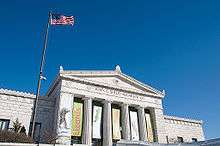 Entrance in 2008
Entrance in 2008 Man with Fish statue next to the building
Man with Fish statue next to the building Main entrance at night
Main entrance at night Cleaning a habitat in the Oceanarium
Cleaning a habitat in the Oceanarium.jpg) Nickel, a Green sea turtle at the aquarium
Nickel, a Green sea turtle at the aquarium A Pacific white-sided dolphin leaping from the oceanarium during the main dolphin demonstration
A Pacific white-sided dolphin leaping from the oceanarium during the main dolphin demonstration Rockhoppers and gentoos at the penguin habitat.
Rockhoppers and gentoos at the penguin habitat. Two belugas swimming in the oceanarium
Two belugas swimming in the oceanarium
- Sea turtle named Nickel
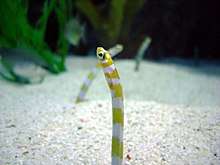 Splendid garden eel from the Wild Reef exhibit
Splendid garden eel from the Wild Reef exhibit Beauty of the Amazon exhibit
Beauty of the Amazon exhibit
Notes
- 1 2 Shedd Aquarium - Explore by Animal
- ↑ Abel, David (2016-08-02). "Top aquariums in the US, in terms of visitors". Boston Globe. Retrieved 2016-12-02.
- ↑ "Currently Accredited Zoos and Aquariums". aza.org. AZA. Retrieved 30 December 2010.
- ↑ "Our Members". ammpa.org. AMMPA. Retrieved 30 December 2010.
- ↑ "Zoos and Aquariums of the World". waza.org. WAZA. Retrieved 30 December 2010.
- ↑ "Explore by Exhibit". sheddaquarium.org. John G. Shedd Aquarium. Archived from the original on May 1, 2013. Retrieved July 25, 2013.
- ↑ National Park Service (2008-04-15). "National Register Information System". National Register of Historic Places. National Park Service.
- ↑ "Shedd Aquarium". National Historic Landmark summary listing. National Park Service. Archived from the original on 2009-06-28. Retrieved 2008-07-23.
- ↑ "Crain's List Largest Tourist Attractions (Cultural): Ranked by 2007 attendance". Crain's Chicago Business. 2008-06-23. p. 22.
- ↑ "Shedd Aquarium Overview" (PDF). January 2006. Archived from the original (pdf) on 2012-04-04. Retrieved 2008-04-17.
- ↑ "Fish Find Comforts of Home in New Aquarium". Popular Science. July 1930. pp. 116–117. Retrieved July 4, 2012.
- ↑ "John Shedd Reed, rail executive". San Jose Mercury News. Associated Press. 2008-03-17. Retrieved 2008-04-23.
- ↑ "John G. Shedd Aquarium 2006 Annual Report" (PDF). 2007-03-01. Archived from the original (PDF) on 2008-06-25. Retrieved 2008-04-23.
- ↑ Johnson, Steve (January 6, 2016). "Shedd Aquarium names Bridget Coughlin as CEO". Chicago Tribune. Retrieved 25 April 2018.
- ↑ "About Shedd: History". Shedd Aquarium. Archived from the original on 2008-05-15. Retrieved 2008-04-17.
- 1 2 Shedd Aquarium, Exhibits: Oceanarium. Retrieved 8 November 2013
- ↑ Mullen, William (2008-05-21). "Shedd Oceanarium to close for upkeep". Chicago Tribune. Retrieved 2008-06-29.
- ↑ DeCarlo, Liz (April 11, 2011). "Jellies exhibit set to open at Shedd Aquarium in Chicago". Chicago Parent. Retrieved 25 April 2018.
- ↑ "Special Exhibit: Amphibians". Shedd Aquarium.
- ↑ Johnson, Steve (May 13, 2015). "'Amphibians' at the Shedd: Poison newt skin and froggy facts". Chicago Tribune. Retrieved 24 April 2018.
- ↑ https://www.sheddaquarium.org/plan-a-visit/visitor-guide/Exhibits/underwater-beauty/
- 1 2 "Granddad: the Aquarium's Oldest Fish". Retrieved 2008-04-17.
- ↑ Mullen, William (December 16, 2009). "Baby beluga survives rough 1st day". Chicago Tribune. Retrieved July 4, 2012.
- ↑ Cancino, Alejandra (January 22, 2010). "Beluga calf thriving at Shedd". Chicago Tribune. Retrieved July 4, 2012.
- ↑ "New beluga baby to make Shedd debut". WLS-TV News. January 21, 2010. Retrieved July 4, 2012.
- ↑ Mullen, William (December 23, 2009). "Beluga whale calf dies at Shedd Aquarium as Brookfield Zoo euthanizes elephant". Chicago Tribune. Retrieved July 4, 2012.
- ↑ "Beluga whale dies at Shedd Aquarium". Chicago Tribune. October 27, 2011. Retrieved July 4, 2012.
- ↑ "New Baby Beluga At Shedd Aquarium Makes Public Debut, Is A Girl". HuffPost. October 23, 2012. Retrieved January 19, 2013.
- ↑ Furnweger, Karen (2012-10-09). "In Loving Memory of Sea Otter Kenai". Shedd Aquarium. Retrieved 2012-10-09.
- ↑ Furnweger, Karen (2013-08-26). "Farewell to Kachemak". Shedd Aquarium. Retrieved 2013-08-26.
- ↑ "Meet Shedd Aquarium's Newest Star, Luna The Sea Otter". CBS Chicago. 12 December 2014. Retrieved 22 December 2014.
- ↑ http://www.sheddaquarium.org/sheddpup/
- ↑ "Nickel: Priceless Sea Turtle". Retrieved 17 February 2014.
- ↑ "Rio Remembrance". Shedd Aquarium.
- ↑ Gamlin, Jim (2013). Because of Nickel: The Adventures of a Used Turtle Salesman. Xlibris Corporation. ISBN 978-1483655284. Retrieved 10 November 2017.
- ↑ "Meet the New Kids on the Block: American Alligators". Shedd Aquarium. Retrieved 10 November 2017.
- ↑ "About Shedd: Architecture Styles". Retrieved 2008-04-17.
- ↑ "Mary Chase Perry Stratton". Craft In America, Inc. Retrieved 2007-04-17.
- ↑ Matthews, Meg. "The Daniel P. Haerther Center for Conservation and Research" (PDF). Retrieved 13 February 2014.
References
External links

- Official website
- Commercials at The Museum of Classic Chicago Television